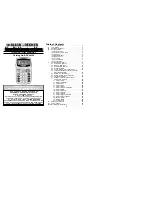
6-38
S
2-Sample
t
Interval
2-Sample
t
Interval
calculates the confidence interval for the difference between two
population means when both population standard deviations are unknown. The
t
interval is
applied to
t
distribution.
Perform the following key operations from the statistical data list.
(INTR)
(t)
(2-S)
7. Distribution
Important!
• Distribution calculations cannot be performed on the fx-7400G
II
.
There is a variety of different types of distribution, but the most well-known is “normal
distribution”, which is essential for performing statistical calculations. Normal distribution
is a symmetrical distribution centered on the greatest occurrences of mean data (highest
frequency), with the frequency decreasing as you move away from the center. Poisson
distribution, geometric distribution, and various other distribution shapes are also used,
depending on the data type.
Certain trends can be determined once the distribution shape is determined. You can calculate
the probability of data taken from a distribution being less than a specific value.
For example, distribution can be used to calculate the yield rate when manufacturing some
product. Once a value is established as the criteria, you can calculate normal probability when
estimating what percent of the products meet the criteria. Conversely, a success rate target
(80% for example) is set up as the hypothesis, and normal distribution is used to estimate the
proportion of the products will reach this value.
Normal probability density
calculates the probability density of normal distribution from a
specified
x
value.
Normal cumulative distribution
calculates the probability of normal distribution data falling
between two specific values.
Inverse normal cumulative distribution
calculates a value that represents the location within
a normal distribution for a specific cumulative probability.
Student-
t
probability density
calculates
t
probability density from a specified
x
value.
Student-
t
cumulative distribution
calculates the probability of
t
distribution data falling
between two specific values.
Inverse Student-
t
cumulative distribution
calculates the lower bound value of a Student-
t
cumulative probability density for a specified percentage.
Like
t
distribution, probability density (or probability), cumulative distribution and inverse
cumulative distribution can also be calculated for
C
2
,
F
,
Binomial
,
Poisson
,
Geometric
and
Hypergeometric
distributions.
On the initial
STAT
mode screen, press
(DIST) to display the distribution menu, which
contains the following items.
Summary of Contents for FX-7400GII
Page 337: ...E CON2 Application ...
















































